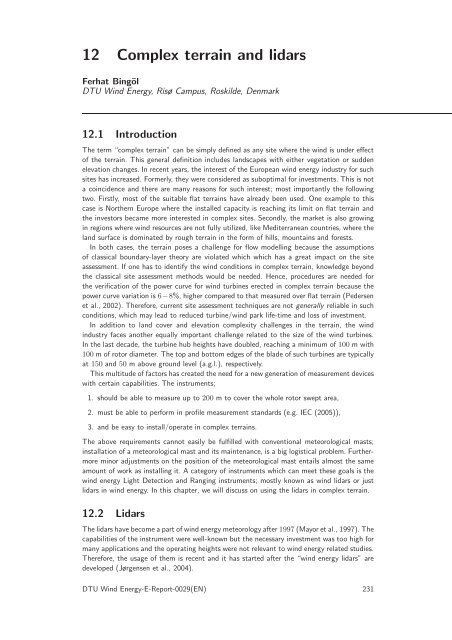Publishers version - DTU Orbit
Publishers version - DTU Orbit
Publishers version - DTU Orbit
Create successful ePaper yourself
Turn your PDF publications into a flip-book with our unique Google optimized e-Paper software.
12 Complex terrain and lidars<br />
Ferhat Bingöl<br />
<strong>DTU</strong> Wind Energy, Risø Campus, Roskilde, Denmark<br />
12.1 Introduction<br />
The term “complex terrain” can be simply defined as any site where the wind is under effect<br />
of the terrain. This general definition includes landscapes with either vegetation or sudden<br />
elevation changes. In recent years, the interest of the European wind energy industry for such<br />
sites has increased. Formerly, they were considered as suboptimal for investments. This is not<br />
a coincidence and there are many reasons for such interest; most importantly the following<br />
two. Firstly, most of the suitable flat terrains have already been used. One example to this<br />
case is Northern Europe where the installed capacity is reaching its limit on flat terrain and<br />
the investors became more interested in complex sites. Secondly, the market is also growing<br />
in regions where wind resources are not fully utilized, like Mediterranean countries, where the<br />
land surface is dominated by rough terrain in the form of hills, mountains and forests.<br />
In both cases, the terrain poses a challenge for flow modelling because the assumptions<br />
of classical boundary-layer theory are violated which which has a great impact on the site<br />
assessment. If one has to identify the wind conditions in complex terrain, knowledge beyond<br />
the classical site assessment methods would be needed. Hence, procedures are needed for<br />
the verification of the power curve for wind turbines erected in complex terrain because the<br />
power curve variation is 6−8%, higher compared to that measured over flat terrain (Pedersen<br />
et al., 2002). Therefore, current site assessment techniques are not generally reliable in such<br />
conditions, which may lead to reduced turbine/wind park life-time and loss of investment.<br />
In addition to land cover and elevation complexity challenges in the terrain, the wind<br />
industry faces another equally important challenge related to the size of the wind turbines.<br />
In the last decade, the turbine hub heights have doubled, reaching a minimum of 100 m with<br />
100 m of rotor diameter. The top and bottom edges of the blade of such turbines are typically<br />
at 150 and 50 m above ground level (a.g.l.), respectively.<br />
This multitudeoffactors has created the need foranew generationof measurement devices<br />
with certain capabilities. The instruments;<br />
1. should be able to measure up to 200 m to cover the whole rotor swept area,<br />
2. must be able to perform in profile measurement standards (e.g. IEC (2005)),<br />
3. and be easy to install/operate in complex terrains.<br />
The above requirements cannot easily be fulfilled with conventional meteorological masts;<br />
installation of a meteorological mast and its maintenance, is a big logistical problem. Furthermore<br />
minor adjustments on the position of the meteorological mast entails almost the same<br />
amount of work as installing it. A category of instruments which can meet these goals is the<br />
wind energy Light Detection and Ranging instruments; mostly known as wind lidars or just<br />
lidars in wind energy. In this chapter, we will discuss on using the lidars in complex terrain.<br />
12.2 Lidars<br />
Thelidarshavebecomeapartofwindenergymeteorologyafter1997(Mayoretal.,1997).The<br />
capabilities of the instrument were well-known but the necessary investment was too high for<br />
many applications and the operating heights were not relevant to wind energy related studies.<br />
Therefore, the usage of them is recent and it has started after the “wind energy lidars” are<br />
developed (Jørgensen et al., 2004).<br />
<strong>DTU</strong> Wind Energy-E-Report-0029(EN) 231

















